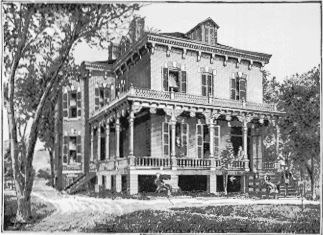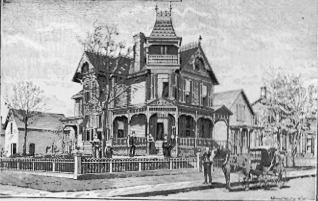|
OMAHA
ILLUSTRATED.
ADAM SNYDER is serving his
first term in the City Council as a member from the Third
Ward. Mr. Snyder is of German descent, and was born in
Baltimore, Maryland, in 1843, where he lived until after the
breaking out of the war. In 1862 Mr. Snyder left home to
seek his fortune in the West, and passed various short
periods of time in Indiana, St. Louis and Springfield. He
then returned to Maryland and remained until 1871, when he
again concluded to go West, and this time to stay. In that
year he came to Omaha, already a live, bustling town, with
great prospects, which Mr. Snyder has lived to see verified.
He began business in a small way, and has prospered greatly,
now doing the largest general meat business in the city. By
carefulness, frugality, attention to business and honest
dealing he has reached independent circumstances. Mr. Snyder
was married November 25, 1876, and now lives very happily
with his wife and one child. As a business man he possesses
the confidence and esteem of his fellow tradesmen. He firmly
believes in the future of Omaha, and, in the Council, has
taken the liberal position in matters of public
improvements. He is opposed at all times to private schemes
and ever watchful of the interests of the public. He is one
of the most regular in attendance of the members and his
vote can always be counted upon the right side. The Omaha
City Council is mostly a body of business men, and Adam
Snyder is one of the best representatives of his class. His
course, so far, has not only commended itself to his
constituents but to the entire public at large.
Chicago, St. Paul, Minneapolis and Omaha's
direct line to St. Paul. The Omaha and Southwestern, also an
Omaha enterprise, of which S. S. Caldwell was president, was
built
to

RESIDENCE OF JOHN M'CREARY.
|
Lincoln in 1869. In 1872 it
passed into the control of the Burlington and
Missouri River Railroad in Nebraska; it was in fact
the parent stem of that great road. The Burlington
Railroad is so closely identified with the growth
and prosperity of Omaha, that it may perhaps be of
interest to outline here a brief sketch of its
progress and development. The Chicago, Burlington
and Quincy Railroad, the parent
|
|
road, was formed by a
consolidation, July 9, 1856, of the Chicago and
Aurora and Central Military Tract Railroads, the
two extending from a point in Illinois about
thirteen miles northeast of Aurora (Turner
junction) to Galesburg, Illinois, the total mileage
being 151 miles. In 1860 and 1862 it acquired the
Northeastern and the Peoria and Oquawaka Railroads,
thus extending its line to Quincy and Burlington,
after
|

RESIDENCE OF F. E. BAILEY.
|
|
which the company built a track
of its own from Aurora to Chicago. From that time
branches and extensions were bought or built in
quick succession, until in 1875 it acquired by
consolidation the Burlington and Missouri River
Railroad in Iowa. This road extended from
Burlington to the Missouri River, and at the end of
1875, the company had increased its mileage to
1,031 miles. The Burlington and Missouri River
Railroad in Nebraska was acquired in 1880, and also
the Kansas City,
|
|

|

|

|
[109]
|